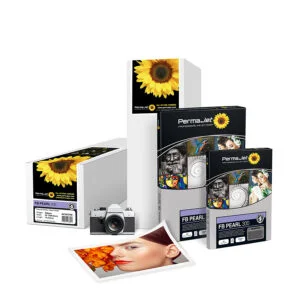When shopping for inkjet paper and canvas you may see the word ‘OBA’ thrown around a lot. But what does it mean? And how important is it when buying paper?
What are OBAs?
OBA is an abbreviation of Optical Brightening Agent, which refers to the chemicals that are added into the coating of some inkjet papers. These chemicals enhance the colour of the paper to give a whiter look. Paper naturally has a creamy yellow colour, so adding OBAs allows manufacturers to offer papers of varying base tones, particularly bright whites.
The way that OBAs work is by absorbing ultraviolet rays (UV) and re-emitting them as blue light. To the human eye, the reflected blue light makes the paper look brighter. This is why prints can sometimes look different under varying lighting conditions where there are different levels of UV.
Below you can see the difference between FB Distinction 320, a paper with OBAs, and Smooth Rag 310 which is OBA free.

Are OBAs bad?
OBAs have a bit of a bad reputation in the print industry. This is because over time, environmental factors can cause the chemicals to break down, resulting in the paper discolouring and returning to its natural colour. You may have seen this happen with old family photos that have yellowed over the years.
There are factors that cause this reaction to happen faster, such as the conditions in which your prints are displayed/stored and the inks that were used. For example, if you use dye-based inks and display the print next to a window, it will yellow much faster than if it was printed with pigment-based ink and displayed in a frame with art glass. This is because UV light causes the breakdown of the chemicals.
Whilst this isn’t a problem for short-term use or low-cost prints, such as prints that will be displayed in an album or on a wall for a few years, if you want your prints to be archivally stable you will need a paper that is OBA free.
Another issue to consider is that OBAs can cause inconsistencies in the colours of your prints. This is due to the changing lighting conditions under which a print might be viewed and the way in which the OBAs will affect the colours under these lights.
OBAs can also make ICC profiles less accurate, as they are dependent on the whiteness of the paper. The spectrophotometers used for profiling papers have UV content in their light source, which is going to differ to the natural UV light you’d be viewing your prints under, thus causing a shift in colours.


When should I use paper with OBAs?
When you prefer a whiter look
When reproducing high-quality images or artwork, paper with OBAs can enhance the visual impact. When printing a vibrant, punchy image or a stark black and white shot, the whiteness of the paper can really accentuate these qualities and lift the colours and highlights.
Short-Term Applications
If the printed materials are intended for short-term use, such as event programs, temporary signage, or disposable brochures, paper with OBAs can be suitable.
Advertising and Marketing Materials
For promotional materials like posters, banners, and signage, using paper with OBAs can make the content more eye-catching and attention-grabbing.
Printing and Publications
If you’re producing materials like magazines, brochures, flyers, or other print publications where brightness and visual appeal are important, using paper with OBAs can be a good choice. The added brightness can make images and text appear more vibrant.

When should I use OBA free paper?
Archival and Long-term Preservation
For documents and materials intended for long-term preservation, such as historical records, important certificates, or archival photographs, it’s best to use paper without OBAs to avoid the yellowing effect.
Art Conservation
In the preservation and conservation of valuable artwork, antique prints, or precious photographs, it’s essential to choose paper that is OBA-free to avoid potential degradation and ensure the longevity of the artwork. As we mentioned earlier it is worth considering other factors for UV exposure such as framing.
Environmental Concerns
You may prefer to avoid paper with OBAs due to environmental considerations. In such cases, you can choose a range of OBA free papers.
Which PermaJet papers are OBA free?
PermaJet have a wide selection of OBA free papers to suit all kinds of requirements. The offering includes papers with a satin finish, smooth matt, and textured matt.
-
 Watercolour Rag 310From £31.63
Watercolour Rag 310From £31.63 -
 Smooth Rag 310From £31.63
Smooth Rag 310From £31.63 -
 Baryta Rag 310From £31.63
Baryta Rag 310From £31.63 -
 Etching Rag 310From £31.63
Etching Rag 310From £31.63 -
 Artist Watercolour 250From £27.46
Artist Watercolour 250From £27.46 -
 Gallery Etching 310From £24.13
Gallery Etching 310From £24.13 -
 Omega Rag 310From £31.63
Omega Rag 310From £31.63 -
 Alpha Natural Rag 310From £32.46
Alpha Natural Rag 310From £32.46 -
 FB Pearl 300From £30.83
FB Pearl 300From £30.83





